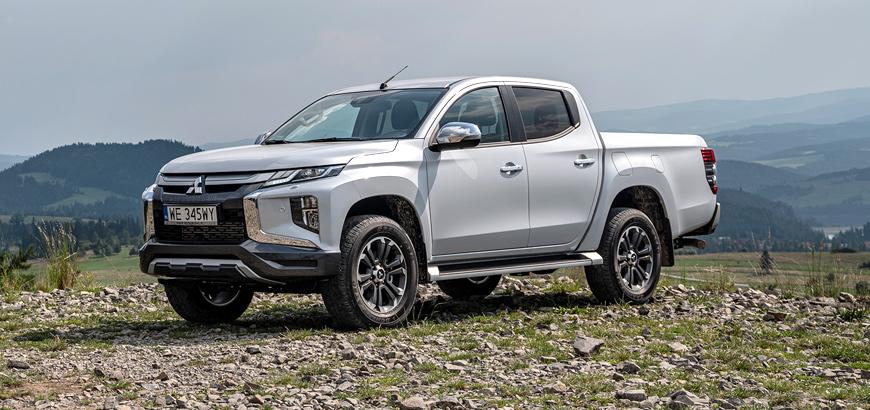You are here
Mitsubishi L200 2.4 DID Double Cab 4WD: Newfound dramatic sensibility
By Ghaith Madadha - Feb 08,2021 - Last updated at Feb 08,2021

Photo courtesy of Mitsubishi
A long time popular player in the increasingly prolific mixed work, play and daily drive compact pick-up segment that accounts for around 90 per cent of Middle East truck sales, the latest generation Mitsubishi L200 is a radically re-imagined design refresh. Chunkier, bolder and far more confidently jutting than its discreetly styled predecessor, the new L200 made quite the impression, and even won the 2020 Middle East Car of the Year awards’ best Midsize Truck category over the deeply impressive Ford Ranger and Toyota Hilux segment stalwart.
Macho makeover
A ruggedly tough, reliable and attainably priced workhorse, the L200 newly adopted and somewhat extrovert design theme however better integrates it with Mitsubishi’s increasingly SUV-heavy line-up and the Japanese manufacturer’s new design themes, as meanwhile old favourites like the long-serving Pajero SUV are also discontinued to make way for newer replacements. Formerly understated with its sloping bonnet and clear sightlines, the new L200 however now boasts a hyper-assertive high rise aesthetic and bonnet line, to rival increasingly more aggressively designed competitors in the mostly Japanese brand dominated segment.
Something of a major design facelift over the previous L200 circa 2015, the new L200 is a far more rugged look, with its brutish new ‘Dynamic Shield’ design language, comprised of a huge, dominant and upright assembly of deep-set side lights and vast lower air intake flanked by chrome strips. Atop this dramatic fascia are the new L200’s slim swept back single-slat grille and headlights. The L200 also features more freshened up rear lights, more angular wheel arches replacing the outgoing model’s rounded arches, and other elements.
Generous output
Powered by a choice of three inline four-cylinder engines, including two work-truck oriented detuned 2.5-litre turbo-diesels and a single naturally-aspirated 2.4-litre petrol through official regional importers, the L200 is also available with more powerful diesel variants that can be independently imported. One such mid power variant of the L200’s DOHC turbocharged 2.4-litre four-cylinder diesel engine develops 151BHP at 3,500rpm and a massive 280lb/ft throughout a broad 1,500-2,500rpm rev range. Reliably tough with its chain-driven timing, it is a relatively smooth diesel without too much diesel clatter.
Low-revving and designed to deliver generous low- to mid-range torque for effortless hauling, towing and off-road driving as trucks in this segment generally are, the L200 nevertheless offers a wider torque sweet spot than expected, and is relatively quick to overcomes the initial moment of turbo lag inertia typical to such diesels at idling engine speed. A flexible and muscularly willing cruiser in mid-range, the L200 2.4 DID charges quite happily through to higher rev maximum power, and is able to achieve a 173km/h top speed.
Intuitive ability
Hauling its 1,930kg mass through the 0-100km/h benchmark in a reasonably quick for its class 12.5-seconds or less, the L200 2.4 DID delivers power to its solid rear axle or all four wheels through a choice of either, slick shifting accurate manual with intuitive clutch biting point, or smooth automatic 6-speed gearboxes. Driving the rear normally, the L200 can engage four-wheel-drive for additional traction and grip when necessary, and features a low gear transfer mode for high power 4WD driving at crawling pace for more demanding conditions and inclines.
For more treacherous conditions, the L200 also features a locking centre differential to significantly improve traction over loose surfaces, whether in high or low gear ratios, Meanwhile, Big 265/60R18 tyres well match its chunky aesthetic, and provide plenty of traction. A capable off-roader with generous 220mm ground clearance, the L200 delivers 30° approach, 24° break-over, and 45° side slope off-road angles — unchanged from its predecessor — allowing it to easily traverse rutted routes and uneven surfaces. A 22° departure angle is, however, slightly less than the previous model.
Rugged and refined
Built using rugged body-on-chassis construction with independent front double wishbone and tough live axle, leaf spring rear suspension, the L200 takes minor and more substantial road imperfections in its stride, but can be slightly bouncy at the rear when not loaded. Manoeuvrable through snaking roads with its light steering providing good in-segment precision, feel and eager, alert turn-in, the L200 is also slightly narrower and shorter in wheelbase than many competitors. Balanced through corners but with slight body lean, the L200 is meanwhile confident, settled and stable on motorways.
Refined inside and with reassuring braking and decent road views for its class, the L200 is easy to manoeuvre and place on road, despite its now higher bonnet and slightly reduced visibility. The L200’s double cab four-door, five-seat cabin is comfortable and spacious, inside, with good headroom and driving position, big side mirrors, easy access and intuitive uncomplicated controls and layouts, and delivers generous cargo capacity. Pleasantly unpretentious inside, up-market variants receive better upholstering and trim, and higher equipment and convenience features.
TECHNICAL SPECIFICATIONS
Engine: 2.4-litre, in-line turbo-diesel 4-cylinders
Valve-train: DOHC, common-rail injection
Gearbox: 6-speed manual, four-wheel-drive
Driveline: low gear transfer, locking centre differential
Power, BHP (PS) [kW]: 151 (154) [113] @3,500rpm
Specific power: 61.8BHP/litre
Power-to-weight: 78.2BHP/tonne
Torque, lb/ft (Nm): 280 (380) @1,500-2,500rpm
Specific torque: 155.6Nm/litre
Torque-to-weight: 196.9Nm/tonne
0-100km/h: 12.5-seconds (estimate)
Top speed: 173km/h
Fuel consumption, urban/extra-urban/combined: 9-/7-/7.7-litres/100km
Fuel capacity: 75-litres
Length: 5,225mm
Width: 1,815mm
Height: 1,795mm
Wheelbase: 3,000mm
Track: 1,520
Overhang, F/R: 885/1,340mm
Minimum ground clearance: 220mm
Loading floor height: 865mm (estimate)
Cargo bed length/width/height: 1,520/1,470/475mm
Approach angle: 30° (estimate)
Break-over angle: 24° (estimate)
Departure angle: 22° (estimate)
Side slope angle: 45° (estimate)
Kerb weight: 1,930kg
Gross vehicle weight: 2,850kg
Towing capacity, braked: 3,100kg
Suspension, F/R: Double wishbones/live axle, leaf springs
Steering: Power-assisted rack & pinion
Turning circle: 11.8-metres
Brakes, F/R: Ventilated discs, 320mm/drums, 294mm
Tyres: 265/60R18
Related Articles
Among the most popular player in the popular compact pick-up segment which accounts for some 90 per cent of truck sales in the Middle East,
One of the more popular pick-ups in the compact pick-up segment, which accounts for some 90 per cent of Middle East truck sales, the Mitsubi
Launched in recent weeks and exclusively for Middle East markets, the Ram 1200 line is expected to greatly expand the former Dodge and now s


















